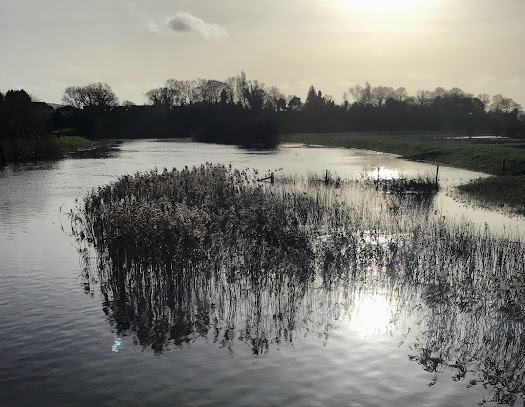Where is St Botolph’s Church?
This painted church is at the west end of Hardham, a hamlet which stretches along a lane set back from the A29 about a mile west of Pulborough. Keep your eyes peeled for the signs. There is space to park a car or two in the lane outside the church. Cycling along the causeway across the marshland of the wild brooks from Pulborough gives a much better feeling for the strange marshland of the Hardham Basin in which the church sits, an enchanting landscape, ringed by the Downs, which the artist knew well.
The oldest medieval wall paintings in Britain?
The frescos of Hardham Church c. 1100 are probably the oldest of the three Sussex ensembles of paintings that have survived. Although badly damaged in places, most of the original artwork remains. The cyclical scheme covers the walls of both the nave and, remarkably, continues in the chancel: we can still walk in the footsteps of those who once followed this pictorial narrative. These are said to be among the earliest surviving and most complete medieval wall paintings in Britain. Wow is a common experience here.
The Sussex muralist
I am going to write as if the same exceptional artistic imagination created the paintings at all three sites. The frescos at Coombes and Clayton do seem to display a more evolved technique and confident expression, which has led some commentators treat the three ensembles as the work of more than one artist. There are, however, strong thematic and stylistic similarities common to all the fresco ensembles, suggesting an artist whose work developed as they returned to expand on previously voiced thoughts and ideas over a number of years. The evolution of one artist’s style and creativity, or the product of many? Perhaps you should visit them all, and then decide for yourself.
 |
| The walls at Hardham are still covered with medieval artwork on almost every available space |
’…insulated almost clear round by ye high stream’
For most of its recorded existence Hardham has been known as an inland peninsula, almost entirely surrounded by water and marshland, joined to the mainland only by a neck of dry land in the west near Coldwaltham. At the opposite end of the peninsula, traffic on the A29 zooms over the modern Swan Bridge, crossing the River Arun as it skirts past Pulborough. Seasonal flooding can still make the 1930’s raised causeway disappear beneath the water, bringing traffic on the A-road to a halt and returning Hardham the serenity and isolation which the muralist knew.
Roman Hardham
During the Roman occupation a garrison was built at the west end of the peninsula, straddling the path over the narrow isthmus from the mainland at Coldwaltham. This was part of a suite of measures which effectively locked down Hardham, securing control of both road and river passage. The road from Noviomagus (Chichester) to London Bridge known as Stane Street (aka the A29) deviates significantly from the usual Roman straight line in order to take advantage of the security offered by Hardham, which became a major hub in a network which fed the insatiable Roman appetite for minerals in Southern England.
Early Christianity, ancient slavery
Christianity came early to Hardham: a lead Romano-British baptismal basin with the early Christian Chi Rho symbol dated to c. 300 CE was discovered during drainage operations in the area in 1943. It is hard to ignore the thought that the first Christians at Roman Hardham may not have been free people, and may not have been locals. The Sussex churches and their frescos lie in a long shadow cast by ancient transportation: these unusual paintings have a great deal to tell us about the perseverance of early Eastern Christian beliefs and practices in England as a long-term consequence of Roman slavery.
Putting out the recycling
On the outside of the church you can still see dressed stone and terracotta tiles from earlier Roman buildings which once stood at this site, reused to build the church. The connection between Roman Hardham and the twelfth-century frescos is literally tangible.
Don’t miss
Allow time to visit the wild brooks, the magical marshland which is the very essence of Hardham. A visit to the RSPB reserve at Wiggonholt https://www.rspb.org.uk/days-out/reserves/pulborough-brooks is a great way to experience the allure of the marshes.



















No comments:
Post a Comment